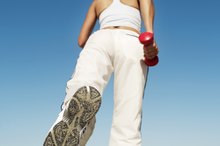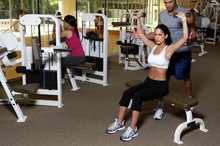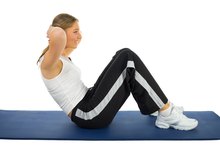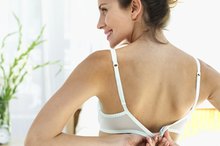Exercise After Breast Implants
If you are fitness-conscious and just had breast augmentation, you'll want to be rocking a hot body to show off the new twins 1. But before you head back to the gym, remember that cosmetic surgery is just as invasive and traumatic to your body as any other surgery. Exercising in moderation will ensure that your body heals properly with minimal risks for infection, scar tissue and stretch marks.
If you are experiencing serious medical symptoms, seek emergency treatment immediately.
Exercise and Implant Size and Placement
The size and placement of your implants will partially determine the type and intensity of exercise you can do immediately after surgery. Implants can weigh 3/4 lb. or more. When they are placed beneath the pectoral muscle, the muscle itself helps support the extra weight, but if the implant is placed in front of the muscle, you will need to take precautions against excessive stretching of the skin and resultant stretch marks. The extra weight may cause soreness in the supporting muscles of the back and neck. Heed your body's warning signs of pain and discomfort, and modify your workout accordingly.
- The size and placement of your implants will partially determine the type and intensity of exercise you can do immediately after surgery.
- When they are placed beneath the pectoral muscle, the muscle itself helps support the extra weight, but if the implant is placed in front of the muscle, you will need to take precautions against excessive stretching of the skin and resultant stretch marks.
Shoulder Joint and Muscle Function
Weight Lifting for Women With Breast Implants
Learn More
Depending on the type of exercise you were doing and your pre-surgery fitness level, implants may or may not interfere with your workout. Adapting from an A cup to a C may be harder than going from a B to a C because the structural change is proportionately greater and may impede movement. Weight-bearing shoulder movements through a large range of motion or ballistic movements as in tennis or volleyball should be minimized until inflammation and pain subside. Avoid kettlebell exercises that require dynamic shoulder movement early on, and resume them with caution.
- Depending on the type of exercise you were doing and your pre-surgery fitness level, implants may or may not interfere with your workout.
- Weight-bearing shoulder movements through a large range of motion or ballistic movements as in tennis or volleyball should be minimized until inflammation and pain subside.
Exercises to Promote Recovery
Exercise done in moderation can help speed recovery from surgery. Low-impact cardiovascular activity like walking or cycling will oxygenate bruised muscles and help reduce inflammation. Avoid high-impact activities initially and wear extra support to prevent excessive breast movement. Moving the shoulder joint slowly through its full range of motion without weights will promote healing and restore flexibility. However, avoid extreme stretching until pain and swelling completely disappear.
- Exercise done in moderation can help speed recovery from surgery.
- Low-impact cardiovascular activity like walking or cycling will oxygenate bruised muscles and help reduce inflammation.
Exercise Alternatives
Can You Exercise When You Have a Seroma?
Learn More
The post-operative phase may be a good time to add alternative forms of exercise to your routine. If you have primarily been running and lifting weights, this may be a good time to try yoga, tai chi or pilates. You may discover new fitness and health benefits while giving the tissue around your breasts time to heal.
Warning Signs
It is normal to experience considerable pain and inflammation after implant surgery, but you should expect a progressive lessening of the two. Exercising too soon or too aggressively after surgery may slow your recovery. If pain and inflammation increase, or if you develop a fever, contact your surgeon immediately. Sometimes scar tissue will form around the implant so tightly that it constricts the implant capsule, causing pressure and hardening. Implants can shift out of their intended location and give you an unbalanced and distorted appearance. Occasionally they will deflate, leaking silicone or saline into your body. If you suspect you have capsular constriction, shifting or deflation, surgical intervention may be indicated.
- It is normal to experience considerable pain and inflammation after implant surgery, but you should expect a progressive lessening of the two.
- Sometimes scar tissue will form around the implant so tightly that it constricts the implant capsule, causing pressure and hardening.
Related Articles
References
- Canada Breast Augmentation: Risks and Complications
- Memorial Sloan-Kettering Cancer Center: Exercises After Breast Sugery
- Gossman W, Shikhman R, Moufarrege R. Breast Implant Rupture. In: StatPearls [Internet]. Updated 11 Nov 2019.
- Grigg M, Bondurant S, Ernster VL, et al., editors. Information for Women About the Safety of Silicone Breast Implants. A Report of a Study by the Institute of Medicine. 2000.
- Al-Lawati T, Kutty R. Breast prothesis leakage and malignant changes of the breast. Oman Med J. 2009;24(2):142–144. doi:10.5001/omj.2009.31
- Risks and complications of breast implants. Food and Drug Administration [internet]. Updated 23 October 2019.
- Baek WY, Lew DH, Lee DW. A retrospective analysis of ruptured breast implants. Arch Plast Surg. 2014;41(6):734–739. doi:10.5999/aps.2014.41.6.734
- Hillard C, Fowler JD, Barta R, Cunningham B. Silicone breast implant rupture: a review. Gland Surg. 2017;6(2):163–168. doi:10.21037/gs.2016.09.12
- Wright T, Wong CS, Schaffner AD. Breast Implants. Updated 5 Dec 2019. In: StatPearls [Internet].
- Nava MB, Rancati A, Angrigiani C, Catanuto G, Rocco N. How to prevent complications in breast augmentation. Gland Surg. 2017;6(2):210–217. doi:10.21037/gs.2017.04.02
- Interview with Adam Tattelbaum, MD – Rockville, MD; conducted on November 14, 2008
- Saline-Filled Breast Implant Surgery: Making An Informed Decision, Mentor Corporation (information provided by the U.S. Food and Drug Administration)
Resources
Writer Bio
Michelle Matte is an accomplished fitness professional who holds certifications in personal training, pilates, yoga, group exercise and senior fitness. She has developed curricula for personal trainers and group exercise instructors for an international education provider. In her spare time, Matte writes fiction and blogs.









